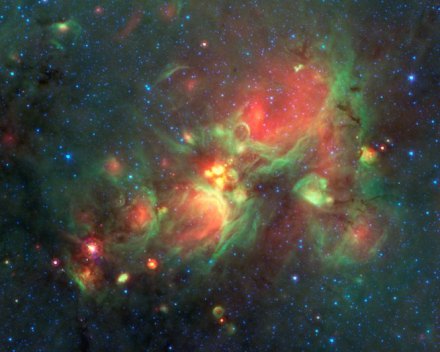Space in Brief: Citizen scientists prompt finding

The background: As part of the Milky Way Project, volunteers scan Spitzer images of the thick plane of our galaxy, where newborn stars are igniting in swaths of dust, according to NASA. The infrared wavelengths detected by Spitzer have been assigned colors.
In addition to the yellow balls, there are green bubbles with red centers populating a landscape of swirling gas and dust. These bubbles are the result of massive newborn stars blowing out cavities in their surroundings.
The green bubble rims are made largely of organic molecules cleared away by blasts of radiation and winds from the central star. Dust warmed by the star appears red in the center of the bubbles.
Researchers believe that the yellow balls precede the green bubble features, representing a phase of star formation that takes place before the bubbles form.
AN ANCIENT SOLAR SYSTEM LIKE OURS: Scientists have discovered a solar system with five Earth-sized planets dating to the dawn of the galaxy, according to the University of Birmingham, England.
Writing in The Astrophysical Journal, the researchers noted a sunlike star hosting five planets with sizes between Mercury and Venus.
The star, known as Kepler-444, was formed 11.2 billion years ago and is 117 light-years away. This is the oldest known system of terrestrial-sized planets in our galaxy -- two and a half times older than the Earth.
A MAMMOUTH SATURN: A planet with a mammoth ring system – larger and heavier than Saturn's rings – orbits a young sunlike star, according to researchers at the Leiden Observatory, The Netherlands, and the University of Rochester, New York.
The ring system, the first of its kind found outside our solar system, was discovered in 2012 by a team led by Eric Mamajek, associate professor at the University of Rochester's physics and astronomy department.
A new analysis shows that the system consists of more than 30 rings, each tens of millions of kilometers in diameter. Researchers also found gaps in the rings, which indicate satellites -- exomoons -- may have formed.
This report was compiled with news releases from NASA, University of Birmingham, England, and University of Rochester, New York.
Related:

